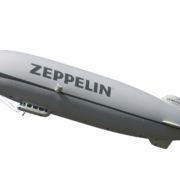Zeppelin
A Zeppelin is a rigid, lighter-than-air airship, also technically known as a dirigible. Invented and built in Germany at the start of the twentieth century by the former military officer Count Ferdinand von Zeppelin, they were used to form the world’s first airline service, used for sightseeing, used for bombing British cities in the First World War, and to carry passengers across the Atlantic in as little as 44 hours. The very long thin cigar-like shape of the zeppelins, which were twice the length of a Boeing 747 aircraft, means sometimes people refer to an object as being “zeppelin shaped”.
Unlike hot air balloons and blimps, zeppelins have a rigid internal structure and originally got their lift from the hydrogen gas which filled them, not the safer helium gas in use today. Helium is inert but hydrogen burns easily, leading to the immensely famous Hindenburg disaster of 1937 when the prestigious transatlantic zeppelin The Hindenburg caught fire while docking in the USA. While public fear, and the much greater speed offered by the emerging airplane services, finished off the zeppelin services of that era, CO2 concerns and other factors may lead to the re-introduction of zeppelins in the twenty-first century.




